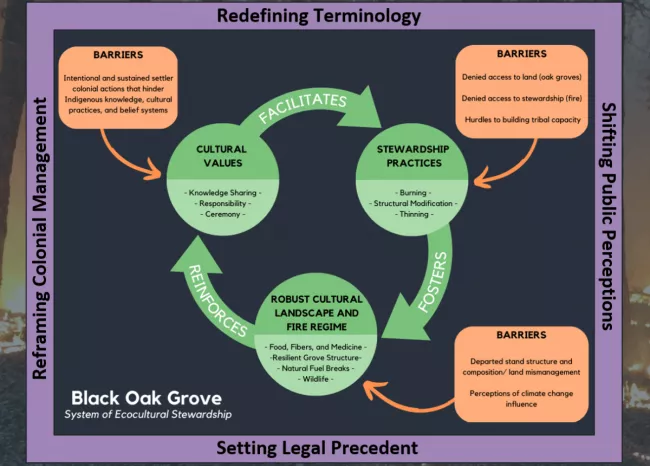Abstract from Jessie Thoreson's MS thesis, full text available here: Karuk Stewardship of Xánthiip (black oak, Quercus kelloggii) in the Western Klamath Mountains: Development of an Ecocultural Monitoring Protocol
My thesis is an exploration of xánthiip (Karuk for black oak, Quercus kelloggii) restoration within the Karuk Tribe’s Ancestral Territory in present-day northwestern California. Black oak is a cultural keystone species for the Karuk and has been chosen as one of the species to guide Tribally led forest restoration work in the Western Klamath Mountains. The fundamental intention of these restoration efforts is to revitalize Karuk stewardship practices including gathering, burning, and ceremonial practices on the landscape. Because of settler colonial actions over the past 100 years, including fire suppression and criminalization of Indigenous land stewardship practices, these black oak groves are highly departed from their historical stand structure and composition. The Karuk Tribe Department of Natural Resources (DNR) is interested in understanding the current state of black of groves of interest from a cultural and ecological perspective in order to make informed decisions about restoration treatments and future adaptive management. Through this thesis, I developed and implemented a culturally responsive monitoring protocol for assessing current black oak tree condition. This research represents a partnership between the Karuk Tribe DNR and myself, an Oregon State University (OSU) master’s student. Research questions and methodology were co-developed based on existing Karuk DNR research priorities. Every step of the research process, from research proposal development, to fieldwork, to writing, to publication, was vetted by a Karuk Tribal Review Committee to ensure that this research was Indigenous-Directed, culturally appropriate, maintained Tribal knowledge sovereignty, and followed appropriate data storage protocols.
Chapter 2 addresses Karuk cultural values and priorities for black oak grove restoration. Our co-developed research question was “What are the values and priorities of Karuk cultural practitioners for revitalizing black oak grove stewardship?” I conducted semi-structured interviews with five Karuk cultural practitioners about their experience with, and knowledge about, black oak grove stewardship. My analysis and interpretation of these interview results highlighted a constellation of attributes that make up a robust system of ecocultural black oak grove stewardship. This system requires an intact cultural value system, intact stewardship practice regimes, and a robust cultural landscape and fire regime. Understanding these cultural values and priorities informed development of a monitoring protocol (Chapter 3) as well as provided cultural and historical context for a qualitative depiction of Karuk black oak stewardship more broadly.
Chapter 3 addresses the process of black oak protocol development, implementation, and plot data analysis. I developed a black oak field monitoring protocol informed by interviews described in Chapter 2 as well as input from Karuk DNR employees and other research partners. We implemented the black oak protocol by collecting field data for 30 focal oak that were historically stewarded by the Karuk. With the field data I asked: 1) What is the relationship between various black oak tree traits? 2) How are those traits related to cultural value according to Karuk cultural practitioners? 3) How are oak trees clustered in trait space based on their trait similarities? Analysis of field data indicated black oak trees are not currently expressing high cultural value in their traits as described by Karuk cultural practitioners. This makes sense in the context of fire suppression and denied Indigenous stewardship. I found tree traits were often closely associated with each other and used trait groupings to identify seven typologies of legacy black oaks. Describing black oak trees based on their traits allows for further research to be more targeted at specific tree typologies of interest and provide a baseline understanding of black oak tree condition to inform the implementation of restoration treatments. Continued monitoring by the Karuk DNR and partners will illuminate how tree traits change in the context of restoration, informing future adaptive management.
This thesis contributes to a body of literature on the cultural and ecological importance of black oak while grounding in a particular place (Western Klamath Mountains), with a particular community (Karuk people). The research of this thesis provides the scientific justification for – and institutionalization of – a culturally informed long-term black oak monitoring by and for the Karuk DNR. Through descriptions of our research partnership development, this thesis also provides one example of Indigenous-Directed Research in practice that may help to inform future partnerships.
